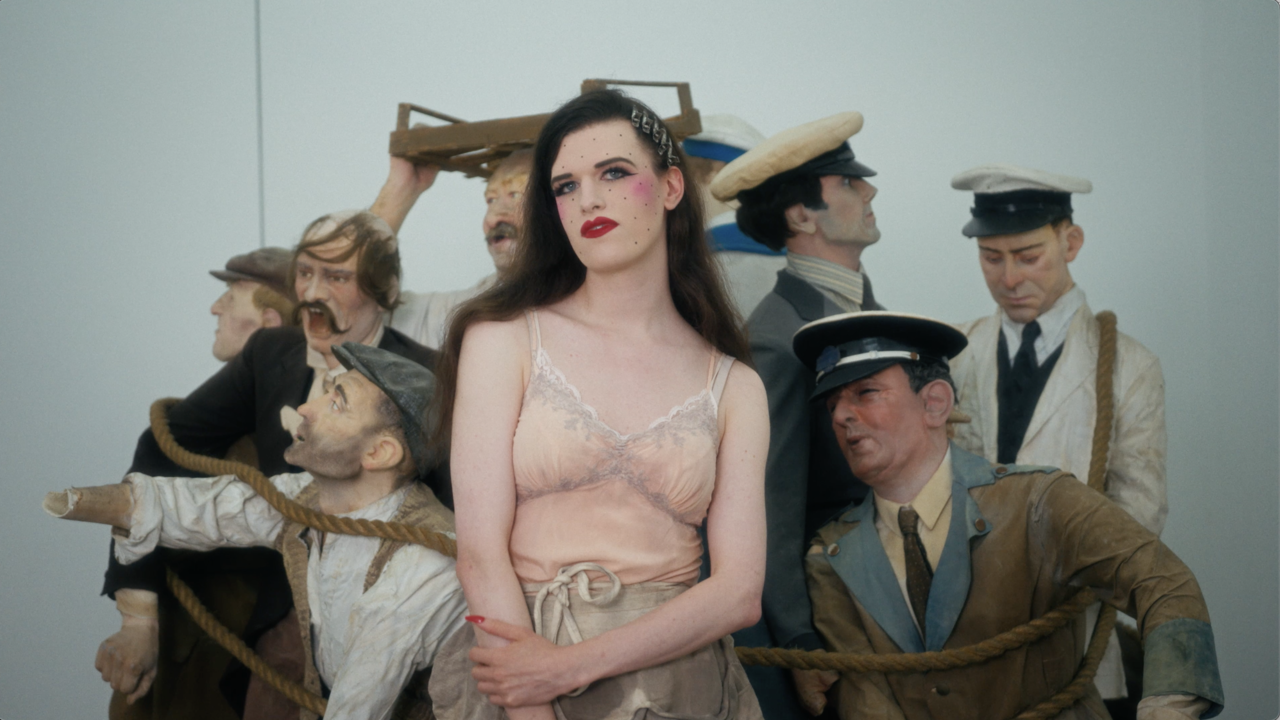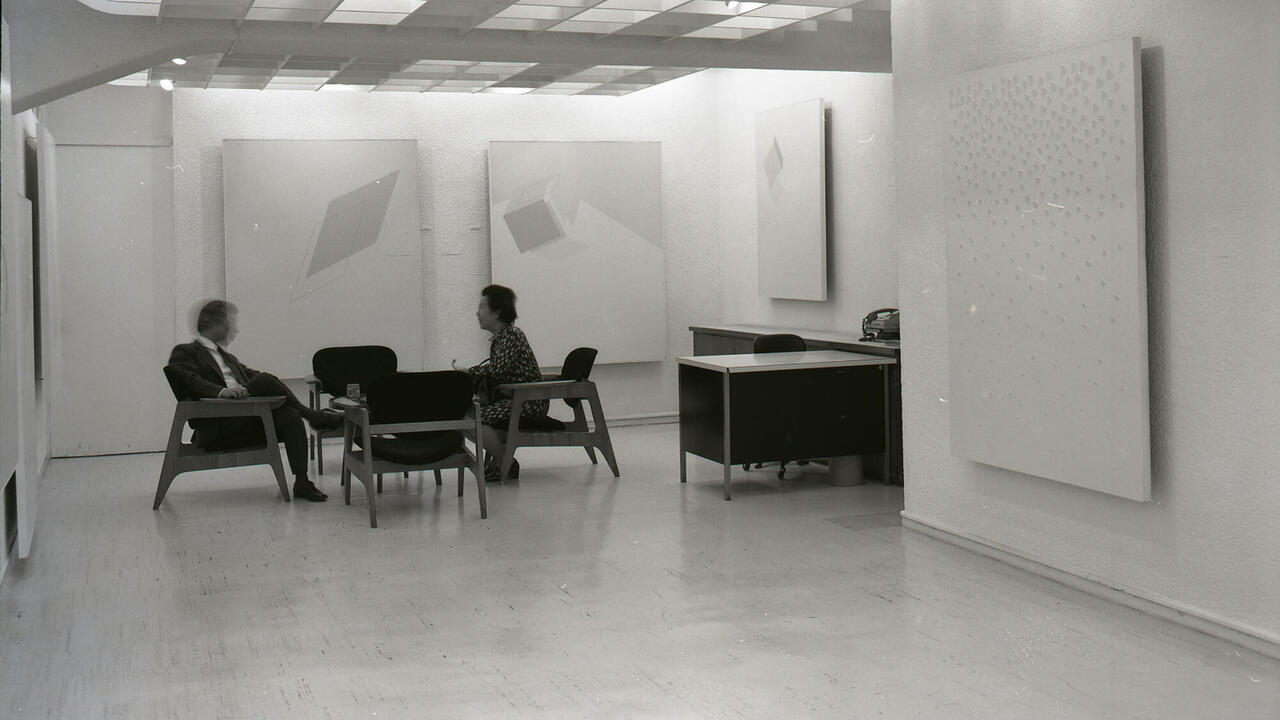Richard Aldrich
Portraits, abstraction and missing pieces; hobbits, systems and Syd Barrett
Portraits, abstraction and missing pieces; hobbits, systems and Syd Barrett

‘Jugband Blues’ (1968), the last song on the last album that Syd Barrett ever recorded with Pink Floyd, includes the line: ‘I’m wondering who could be writing this song’. Sung by Barrett, who also wrote it, the song famously prefigures the mental breakdown that transformed him from an art-school mod to a reclusive cult hero. Barrett has been a presence in the work of Brooklyn-based artist Richard Aldrich for much of the artist’s career. In Syd Barrett Portrait (2006) the musician’s head and shoulders float in the middle of a white canvas, his blue eyes peering nervously from behind a mangy, Medusa-like mane. Aldrich’s thick, painterly brush strokes only intensify the instability of the subject.
For more than a decade, Aldrich has been producing paintings and sculptures that play with ideas of identity. His works – mostly abstract paintings, some with cuts and missing pieces, others with collaged media or texts – evoke the genres of 20th-century painting like distant memories. Abstract Expressionism, Minimalism, even German ‘bad painting’ of the 1980s are discernable. But as quickly as they appear, precedents disappear.
By his own admission, Aldrich is interested less in the finished work than in ‘systems’. It’s the sort of statement that raises more questions than it answers, in that ‘system’ denotes a function rather than a thing. If Aldrich’s works can seem varied or hard to pin down it’s because they are not objects as culminations of a concept so much as the products of an unseen (and unfixed) theatre of thoughts and actions.

It’s a process that was made explicit in Aldrich’s 2008 exhibition at Corvi-Mora in London. ‘Narrative with Five Characters’ comprised a series of small abstract paintings, along with four small sculptures (a dragon puppet, a paper bag, a troll figure, a concrete cast of the letter ‘O’) and Hobbit Painting (2006–8), a cartoonish drawing that imagines hobbits as grim versions of Snow White’s dwarves. If the title re-configured the gallery as a theatre, it also triggered a tension between the players. The facile division between the five representational pieces as the ‘characters’ and the abstracts as the ‘narrative’ disintegrates, as the correlation between a recognizable form and a character intersects with ‘narrative’ abstraction. The interdependence between narrative and characters that constitutes conventional theatre is posited as a fragile semantic function.
A similar process is evident in the two paintings of Looking with Mirror Apparatus (2008). The same image – a muddy brown head shape atop black shoulders, approximating a figure seen from behind – is repeated on a large and a small canvas. The lower third of the large painting is cut away to reveal a small mirror fixed to the middle stretcher bar. While the repetition of forms in different sizes activates a formalist dialogue between the two paintings, the missing piece intercepts the one-to-one identification. The addition of the mirror adds to the disequilibrium by involving the viewer: two figures become three or more; paintings on a wall become both scaffolding and actors in a drama with neither a narrative nor an end.
Looking with Mirror Apparatus was among the primarily abstract paintings in Aldrich’s 2009 exhibition at Bortolami Gallery in New York, all of which echoed one another in the flatness and soft, autumnal tones of the paint, without submitting to the finality of a closed conceptual set. In the three-part press release for the exhibition – a composite of narrative, poetry and explication – the author (presumably the artist) states that, ‘meaning is created by the interpretation […] The art works become connecting tissue for the thoughts and revelations of the viewer. The art works become mirrors for the viewer to re-view themselves in.’

Aldrich has described his paintings as taking the ‘back way’ out of meaning. It’s another statement that raises more questions than it answers; it means refusing the expected, pulling away just as A approaches B. In a sense, Aldrich is evading his role as a creator of images. His paintings are understated and often beautiful and his use of oil and wax invests them with the weight of endurance. These are precious objects, whether it’s intentional or not. But Aldrich’s equivocations deny neither the works’ meaning nor their value. Rather, they are reminders that a painting involves seeing, thinking and doing. His latest works include a series of ‘slide paintings’, vast, white canvases with coloured slides of past art works and installations attached to them in a spare grid formation. Time elapses. If something seems inconsistent or missing, it may be that we can’t discern its logic.
Split Syd (2008) is a sparse canvas with a two-toned brown arc at the top and fuzzy red lines, which could be an abstracted spider or a striped shirt, near the bottom, with nothing but the white ground in between. If Syd is there, he’s not talking, but ‘there’ is not where the action is.





















